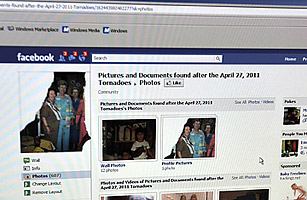
Alycia Williamson-Smith and her family didn’t have anywhere else to turn. It
had been days since a devastating tornado ravaged Joplin, Mo., home to her
second cousin James Williamson. With cell-phone service largely unavailable and a
distance of several thousand miles between her house in Amsterdam, N.Y., and
Joplin, Williamson-Smith posted photos of James on several Facebook pages
that were created in the aftermath of the tornado. Less than 24 hours later, she saw a comment on a page called “Joplin Tornado Citizen Checks” that said James had been found and was volunteering with search-and-rescue teams. “Even though at that point we hadn’t spoken to him directly, it was comforting to know that someone out there had seen him and that he was O.K.,” says Williamson-Smith.
Two weeks after the storm, that Facebook page had about 6,500 “likes” and was still growing every day. Stories of joyful reunions mixed with those mourning the loss of loved ones, along with messages about supplies, prayers and support. The page was one of dozens that sprouted in the immediate aftermath, quickly becoming the fastest way to get information, as survivors and their relatives relied on social media as they might once have leaned on the Red Cross or local relief agencies. “The biggest part of using social media during a disaster is that it’s not about the government helping the public; it’s about the public helping themselves,” says Kim Stephens, a senior associate at ABT Associates and an emergency-management expert. “Before, you were left trying to find out how to get what you need, and now the desire and need is matched quickly and easily. It’s peer-to-peer aid.” Halfway around the world in Japan, social media was a primary source of communication following the earthquake and tsunami that struck on March 11. However, unlike the situation in Joplin, citizens were using networks like Twitter, Facebook and Mixi to send warnings, ask for help and relay bits of information from the scene as well as to announce that they were safe. According to Mashable, only an hour after the earthquake, more than 1,200 tweets per minute were being sent from Tokyo. Hashtags like #prayforjapan, #earthquake and #tsunami trended almost instantly, and were being tweeted thousands of times per second by people all over the globe, according to Poynter. And not surprisingly, Twitter reported both a record number of tweets the day of the quake and accounts added one day after .
Jesse Green, executive director of the Tokyo office for p.r. firm Hill & Knowlton, was in Beijing when the earthquake hit Japan. He used Facebook and Twitter to connect with his family, friends and co-workers as well as to receive updates on the situation. “[Social media] helped to an extent I would never have previously imagined,” Green says. “Many of my friends, my wife included, joined Twitter just to keep up with all the breaking news and be part of the conversation where possible. While the broadcast media gave their global audience an understanding of what was taking place, social media provided the underlying picture — especially useful for those of us living in Japan, where the top-line details simply weren’t enough.” While conventional telephone lines often go down or become overwhelmed during a disaster, Internet connections often remain active and usable. “People can get out texts or tweets way easier than they can get out a phone call, and that’s something [emergency managers] don’t plan for,” Stephens says. “Most of the planning is based on the assumption that there will be no communications in the impacted area. That’s become a false assumption. Now we know that there are communications.”
With that in mind, the Federal Emergency Management Agency ,
Department of Homeland Security and Federal Communications Commission
have all implemented social strategies into their emergency-management
plans. In April, the Department of Homeland Security announced that it would
revise its terrorism-advisory system, including a provision that alerts would
be sent out over social networks “when appropriate.” Shortly thereafter,
FEMA and the FCC, along with New York City Mayor Michael Bloomberg, unveiled
PLAN , the nation’s first
geographically targeted emergency-notification system, which sends free
emergency alerts to enabled mobile devices to warn citizens of “imminent
threats” in their area. This service is expected to roll out in New York City by the
end of the year.
Of course, as with anything on the Web, social media has a tendency to
breed rumors and inaccuracies that could hurt recovery efforts. And as
Amanda Ripley, a TIME contributor and author of the book The Unthinkable:
Who Survives in Disasters and Why, points out, during disasters, people
have a tendency to move slowly or shut down completely as a protective
measure. “Anything that exacerbates that tendency — texting, taking
pictures, tweeting — can be dangerous,” she says.
It’s true that social media is often thought of as nothing more than a distraction, or an attempt to replace a real community with a virtual one. But when faced with a disaster like in Joplin or Japan, these networks become a lot more. “I think that citizens communicating with other citizens, well, that’s kind of the definition of resilience,” Stephens says.
See pictures of the wreckage in Joplin by photojournalist Edward Keating.
See TIME’s photo-essay “The Calamity of Japan’s 9.0-Magnitude Quake.”